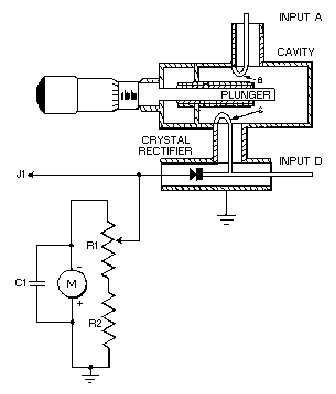3-36
Figure 3-27.—Typical cavity wavemeter.
The wavemeter illustrated is of the type commonly used for the measurement of microwave
frequencies. The device employs a resonant cavity, which effectively acts as a high-Q LC tank circuit.
The resonant frequency of the cavity is varied by means of a plunger that is mechanically connected to a
micrometer mechanism. Movement of the plunger into the cavity reduces the cavity size and increases the
resonant frequency. Conversely, an increase in the size of the cavity (made by withdrawing the plunger)
lowers the resonant frequency. The microwave energy from the equipment under test is fed into the
wavemeter through one of two inputs, A or D. A crystal rectifier then detects or rectifies the signal, and
the rectified current is indicated on the current meter, M.
The instrument can be used as either a transmission type or an absorption type of wavemeter. When
used as a transmission wavemeter, the unknown signal is coupled into the circuit by means of input A.
When the cavity is tuned to the resonant frequency of the signal, energy is coupled through coupling loop
B into the cavity and out through loop C to the crystal rectifier where it is rectified and indicated on the
meter. At frequencies off resonance little or no current flows in the detector and the meter reading is
small. Therefore, the micrometer and attached plunger are varied until a maximum meter reading is
obtained. The micrometer setting is then compared with a calibration chart supplied with the wavemeter
to determine the unknown frequency.
When the unknown signal is relatively weak, such as the signal from a klystron oscillator, the
wavemeter is usually used as an absorption type of device. Connection is made to the instrument at input
D. Rf loop C then acts as an injection loop to the cavity. When the cavity is tuned to the resonant
frequency of the klystron, maximum energy is absorbed by the cavity, and the current indicated on the
meter dips. When the cavity is not tuned to the frequency of the klystron, high current is indicated on the
current meter. Therefore, the cavity is tuned for a minimum reading, or dip, in the meter; and the resonant
frequency is determined from the micrometer setting and the calibration chart.

